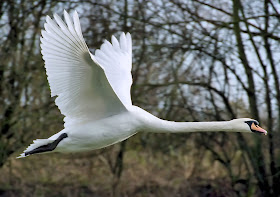Beauty Of Animal | Swan | The swan is a large aquatic bird closely related to geese and ducks. The swan is known for it's fierce temperament and the swans incredibly strong wings which are said to be able to cause dangerous (sometimes fatal) injuries to any animal the swan feels threatened by. The swan is found on both sides of the Equator across the Northern and Southern Hemispheres. The northern swan is generally white in colour with an orange beak and the southern swan tends to be a mixture of white and black in colour with red, orange or black beaks.
The Australian black swan has been noted to only swim with one leg, the other being tucked above it's tail. This helps the swan to change direction more smoothly when the swan is swimming on the surface of the water, should the swan spot food or even an oncoming predator. Swans are omnivorous birds but have a very vegetarian diet. Swans eat underwater vegetation such as seaweed and aquatic plants when they are on the water and a mixture of plants, seeds and berries when they are on land. Swans also eat insects both water and land based and the occasional small fish.
Due to their large size, swans have few natural predators in the wild. The swan's main predator is the human who hunts the swan for it's meat and it's feathers. Other predators of the swan include wolves, raccoons and foxes they prey both on the swan itself but also on it's eggs. Although swans do not mate for life, couples establish strong bonds between one another and can often mate for a few years. Swans build their nests on land out of twigs and leaves, and the female swan lays between 3 and 9 eggs. The baby swans (known as cygnets) hatch out of their eggs after an incubation of just over a month. The cygnets are often on the water with their mother swan within a couple of days and stay close to her for both protection and warmth. The mother swan will guard her baby swans furiously from predators or any animal that she believes is a threat.
Swans have many adaptations in order to successfully survive life on the water such as their streamline body shape, long neck and webbed feet. The wings of the swan are also very strong meaning that the swan is one of the few heavy birds that is able to fly, even if it is only a short distance. There are around 7 different species of swan found around the world. The size, colour and behaviour a swan individual is largely dependent on it's species and the area in which it lives.
Swans have many adaptations in order to successfully survive life on the water such as their streamline body shape, long neck and webbed feet. The wings of the swan are also very strong meaning that the swan is one of the few heavy birds that is able to fly, even if it is only a short distance. There are around 7 different species of swan found around the world. The size, colour and behaviour a swan individual is largely dependent on it's species and the area in which it lives.
Today swans are a threatened species of animal mainly due to hunting and habitat loss. Pollution (mainly water pollution) is also a major reason as why the swan populations are declining. Humans kept swans for many years for their meat, but today have more respect for the conservation of the swan and keep more sustainable animal food sources.
Find Here The Kinds Of Animals and Flora and Fauna





